Seven-spot ladybirds are probably the most well-known ladybirds in our country and are among the first beneficial insects ever to be used for biological pest control.

Every gardener is familiar with the pests aphids (Aphidoidea) that feed on the sap of beloved plants. Luckily there is a natural opponent, namely him ladybug. This article is specifically about the seven-spot ladybug (Coccinella septempunctata).
contents
- Seven-point ladybug: profile and way of life
-
Seven-spot ladybird as a beneficial insect against aphids
- How do seven-spot ladybugs fight aphids?
- Procedure for use as a beneficial insect
Seven-point ladybug: profile and way of life
The seven-spot ladybug, like any insect, has 6 legs, reaches a body length of 5 to
8 mm and, as the name suggests, has 7 points. A special feature of the Coccinella septempunctata is the seventh point, which is separated by the two wings and flanked by two bright, elongated spots. There are two white dots on the front part of the chest, as well as on the head between the two black eyes. The seven-spot ladybug has two feelers that it can use to "smell" and touch. Unlike other ladybird species, the seven-pointed beetle is clad very uniformly: there are only rarely animals that differ in terms of the number of points or color of the elytra.
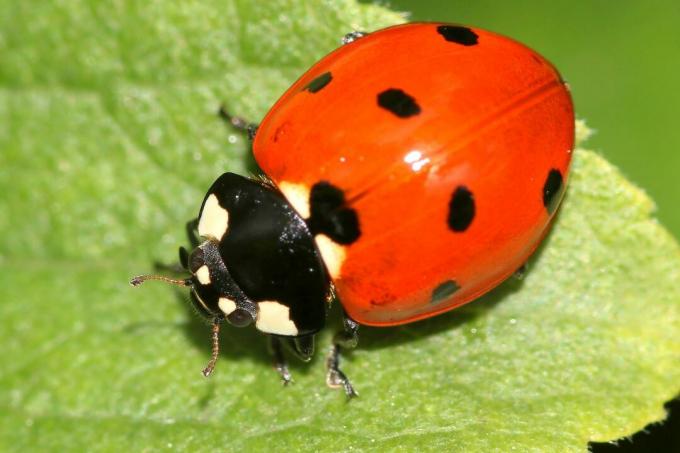
Coccinella septempunctata are polyphagous, i.e. they have a very wide range of food. In addition to aphid species, which are absolutely necessary for the development of the larva, other food such as thrips (Thysanoptera), leaf beetles (Chrysomelidae) and even eggs of their own species.
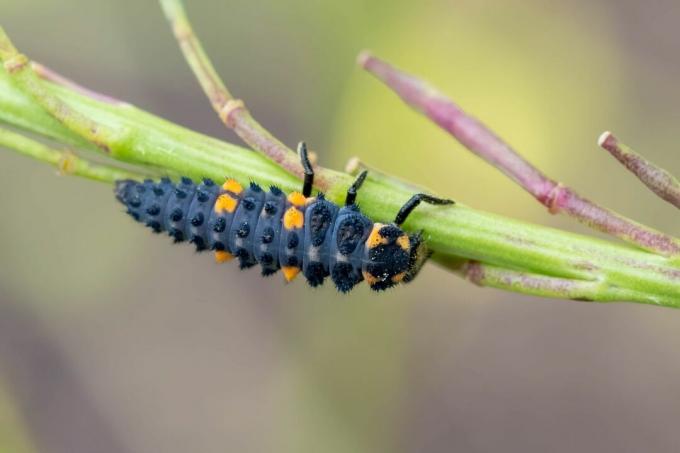
Seven-spot ladybirds, along with the two-spot ladybirds, are the most common species found in Germany and often overwinter in colonies on damp ground, surrounded by leaves, grass or moss. As soon as the temperatures rise, the mating season begins. Egg-laying begins at the end of April, with a female laying up to 400 eggs on plant parts that are usually already infested with aphids. A few days later, the first seven-spot ladybird larvae hatch and prey on the aphids. After three molts, the larvae pupate and about a week later a seven-spot ladybird hatches from the pupa.

In Germany, seven-spot ladybirds usually form only one generation per year, in more southern countries there are quite often two generations per year. In India even 15 to 20 generations have been observed. Each individual of the seven-spot ladybug lives to be around 12 months old.
During this time, it changes its preferred habitat: larvae grow up protected in herb layers. The beetles migrate to shrubs to feed on ripening and then spend the winter on trees, in houses or on the ground. In the spring they go back to where their larvae are protected and can grow close to the ground on herbaceous plants to lay their eggs.

The seven-spot ladybugs feed mainly on their neighbors, the aphids. When the lice become scarce, feeds Coccinella septempunctata if necessary, also from pollen and fungal spores or migrates to the next aphid colony. The activity of the beetle depends on the weather: from 18 °C and without rain, the eggs develop into the pupa within two months. At 25 °C, on the other hand, it only takes 15 days.
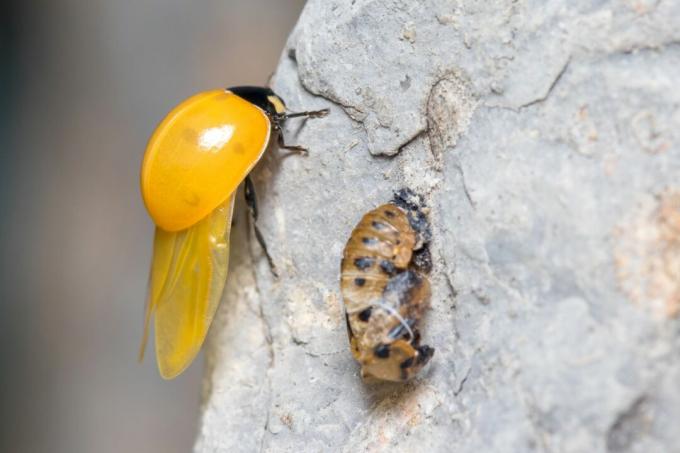
Seven-spot ladybird as a beneficial insect against aphids
For a natural and effective aphid control without any synthetic pesticides, for example, the use of our Plantura seven-spot ladybird Possible and effective from around 18 °C. In order for you to be successful in using seven-spot ladybugs, there are a few things you should keep in mind.
Successful use of seven-point ladybugs:
- Refrain from using chemical pesticides 6 weeks in advance.
- If necessary, remove excess ants before use.
- At the fighting site there should be at least 18 °C.
- Use in enclosed spaces such as conservatories, rooms and greenhouses is far more effective than outdoors where the beetles tend to migrate.
- If the conditions are good, the success of the application can be seen after a few days.
tip: Beneficial insects like our ladybugs are sensitive to pesticides. However, some of these are less harmful to the beetles or are broken down so quickly that the waiting time between their application and the use of beneficial organisms: agents based on rapeseed oil or potash soap and neem preparations like ours Plantura Organic Pest Free Neem can be used for a week before receiving the beneficial insects to decimate the pests.
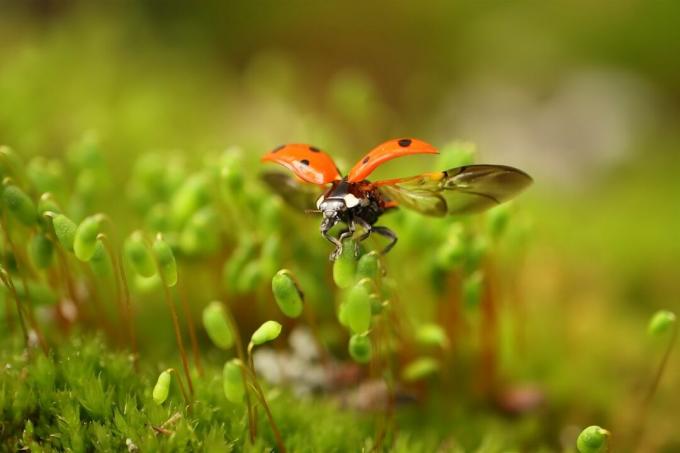
How do seven-spot ladybugs fight aphids?
Seven-spot ladybugs lay their eggs on plants that are already infested with aphids. The newly hatched ones Coccinella septempunctata Larvae are particularly voracious and, depending on the species of aphid, eat up to 1200 lice during their Development time, while adult seven-spot ladybirds only have up to 150 aphids a day Wolf down. Young larvae of the seven-spot ladybird usually also consume smaller prey by biting and then sucking them out. Larger larvae and adult beetles, on the other hand, can chew up their food completely.
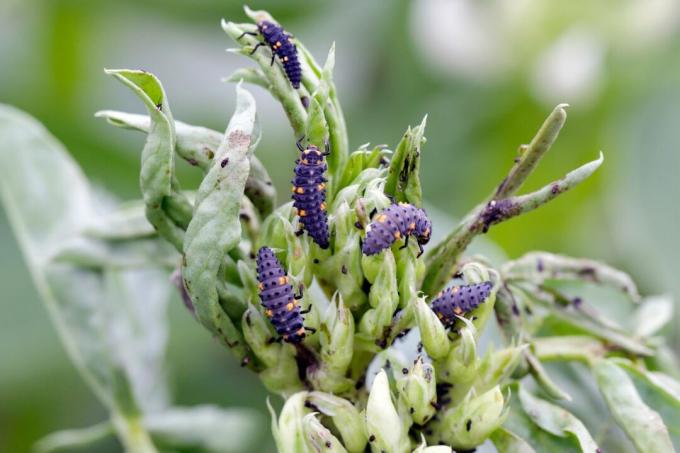
Procedure for use as a beneficial insect
How to use ladybugs as beneficial insects:
- 150 beetles are enough to control about 10 m² of infested area.
- Place the plants as close together as possible so that the seven-spot ladybugs can easily migrate from one plant to the next.
- Apply on receipt, if possible on the same evening or the following morning.
- Open the packaging at the application site.
- Carefully remove the pieces of foil with the eggs and place them at the infested site.
- Alternatively: Fastening with clothespins.
- As close as possible to the aphids.
- min. 18 °C, avoid places with strong sunlight.
- Wait, observe and after approx. Check control success after 3 weeks.
Not only seven-spot ladybugs, but also many other animals can help you against pests. In our special article we present you 10 beneficial insects that you should know about and promote in your garden.
